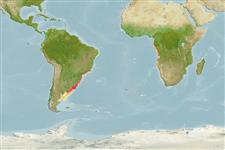Environment: milieu / climate zone / depth range / distribution range
Écologie
marin démersal; profondeur 10 - ? m (Ref. 27363). Subtropical; 1°S - 46°S, 68°W - 14°E
Eastern Atlantic: known only from larvae collected in the southern Gulf of Guinea from Annobon, Equatorial Guinea to Mossamedes (Moçâmedes), Angola. Western Atlantic: Rio de Janeiro, Brazil to San Jorge Gulf, Argentina (Ref. 86990).
Taille / Poids / Âge
Maturity: Lm ? range ? - ? cm
Max length : 112 cm TL mâle / non sexé; (Ref. 57911)
Description synthétique
Morphologie | Morphométrie
Pectorals small and fan-shaped (Ref. 27363).
Found in shallow waters of the continental shelf (Ref. 27363). Feeds on fishes, shrimps, crabs and mollusks.
Life cycle and mating behavior
Maturité | Reproduction | Frai | Œufs | Fécondité | Larves
Specimens captured in deep waters of Brazil had ovaries occupying the whole abdominal cavity with scarce adipose tissue and degraded body indicative of semelparity (Ref. 92882).
Smith, D.G., 1990. Congridae. p. 156-167. In J.C. Quero, J.C. Hureau, C. Karrer, A. Post and L. Saldanha (eds.) Check-list of the fishes of the eastern tropical Atlantic (CLOFETA). JNICT, Lisbon; SEI, Paris; and UNESCO, Paris. Vol. 1. (Ref. 4453)
Statut dans la liste rouge de l'IUCN (Ref. 130435)
Menace pour l'homme
Harmless
Utilisations par l'homme
Pêcheries: intérêt commercial mineur
Plus d'informations
RéférencesAquacultureProfil d'aquacultureSouchesGénétiqueElectrophoresesHéritabilitéPathologiesTraitementNutrientsMass conversion
CollaborateursImagesStamps, Coins Misc.SonsCiguateraVitesseType de nageSurface branchialeOtolithesCerveauxVision
Outils
Articles particuliers
Télécharger en XML
Sources Internet
Estimates based on models
Preferred temperature (Ref.
123201): 11.8 - 24.9, mean 15.8 °C (based on 168 cells).
Phylogenetic diversity index (Ref.
82804): PD
50 = 0.5000 [Uniqueness, from 0.5 = low to 2.0 = high].
Bayesian length-weight: a=0.00043 (0.00024 - 0.00076), b=3.23 (3.08 - 3.38), in cm total length, based on LWR estimates for this species & Genus-body shape (Ref.
93245).
Niveau trophique (Ref.
69278): 3.7 ±0.59 se; based on food items.
Generation time: 7.3 ( na - na) years. Estimated as median ln(3)/K based on 1
growth studies.
Résilience (Ref.
120179): Milieu, temps minimum de doublement de population : 1,4 à 4,4 années (Assuming tm<5).
Fishing Vulnerability (Ref.
59153): High vulnerability (61 of 100).
Climate Vulnerability (Ref.
125649): Moderate vulnerability (38 of 100).
Nutrients (Ref.
124155): Calcium = 44.1 [26.7, 86.9] mg/100g; Iron = 0.851 [0.485, 1.384] mg/100g; Protein = 18.6 [15.8, 21.4] %; Omega3 = 0.3 [0.1, 0.8] g/100g; Selenium = 52.3 [28.1, 102.7] μg/100g; VitaminA = 7.4 [2.2, 24.5] μg/100g; Zinc = 0.556 [0.410, 0.786] mg/100g (wet weight);
